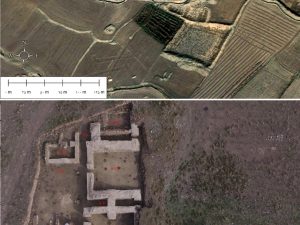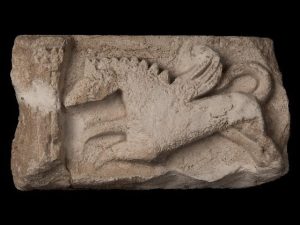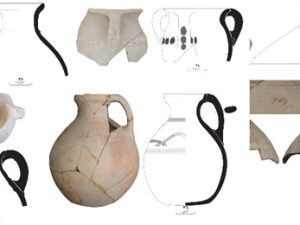Jahangirجهانگیر
Location: Jahangir was an archaeological site in western Iran, Ilam Province.
33°54’44.2″N 46°08’50.4″E
Map
Historical Period
Sasanian
History and description
On the southeastern side of the central mound, there is a rectangular hall that measures 11×19 meters. A square-shaped building, 58×58 meters, with four round-shaped towers, is located on the west and northwest of the hall (fig. 1). The building seems to have undergone three construction phases. It was initially built with slabs and semi-fired bricks and semi-impressed gypsum. In the second phase, other buildings were added to the main one, and probably some reconstructions were made. In the third phase, the building was abandoned to be occupied later by nomads and squatters.
Archaeological Exploration
In 2001, the archaeologist Bayan Pirani conducted an archaeological survey in the region and recorded the sites of Jahangir and Gowriyeh. Later, Ebrahim Moradi carried out another survey in the Kangir River Basin, which resulted in identifying 11 sites in this region. Because of the construction of a dam on the Kangir River, Hamid Amanollahi undertook soundings at Jahangir in 2015. The site was finally excavated in full by the author from 2016 to 2019.
Finds
Finds consist of stuccos (fig. 2) mostly used to cover and decorate walls. The human, animal, and floral motifs were used in geometric decorated frames with typical Sasanian artistic motifs. The stone finds included stone mills, hand stones, mortars, weight stones, knife sharpening stones, etc. In addition, the metal objects included bracelets, rings, earrings, coins, and so on, while other finds consisted of glass, bone, and plant objects. Ceramic finds include potsherds (rims, bases, and body) and complete shapes such as jars, plates, and small and large tableware. Pottery colors are usually pea, petiole brick, red, and gray; and the bonding materials are mineral. Ceramics (fig. 3) are divided into two groups non-glazed and glazed pots. There are some ostracas or written potsherds from the Sasanian period.
Bibliography
Khosravi, L., Archaeological Excavation Reports of Jahangir, Tehran: Archaeological Documentation Research Center and Cultural Heritage and Tourism Research Center. Unpublished reports (2014-2019).
Khosravi, L. and E. Ghorbani, “Geological, Hydrological, Geomorphological, Seismotectonic, and Morphotectonic Studies of the Jahangir Ancient Zone along the Kangir River, Eyvan County, Ilam Province,” Iran Quarterly, No. 3/1, 2018, 75-93.
Khosravi, L., “Newly Found Stucco Remains from the Sasanian Noble Residence at Gowriyeh and Jahāngir near the Kangir River of Eyvan, Ilam Province”, Pazhuhesh-hā-ye Bāstānshenāsi-ye Iran, vol. 24, 1399/2021, 141-167. In Persian
Khosravi, L., “An Overview on Three Seasons of Archaeological Excavations in Jahangir Site, Journal of Archaeological Studies, Vol. 12, 4 (24), 2021, pp. 77-94. Khosravi, L., “New Archaeological Excavations of the Jahangir and Gowriyeh manor Houses in the West of the Sassanid Empire”, Iran, vol. 59/2, 2021.
Author: Leila Khosravi
Originally published: July 15, 2022
Last updated: January 11, 2025




































































































































